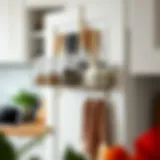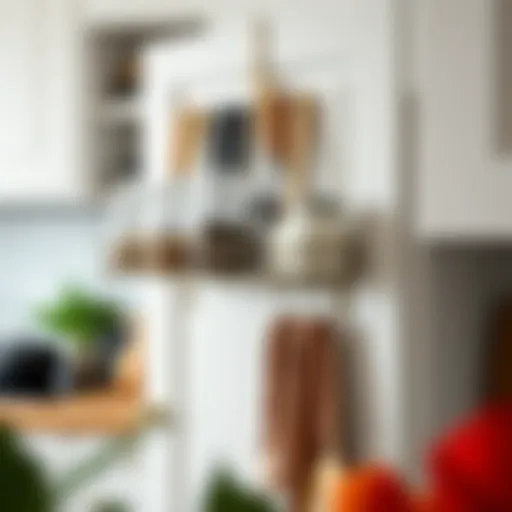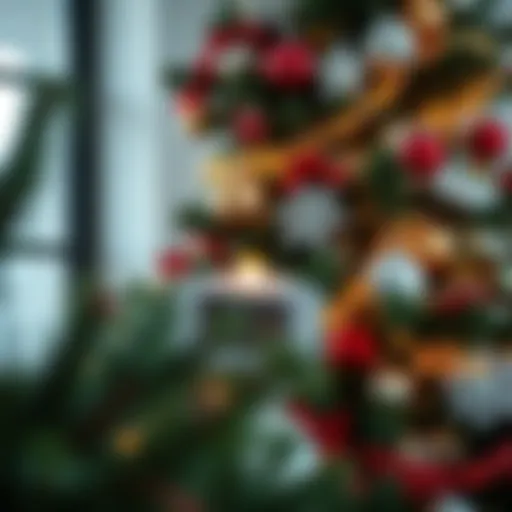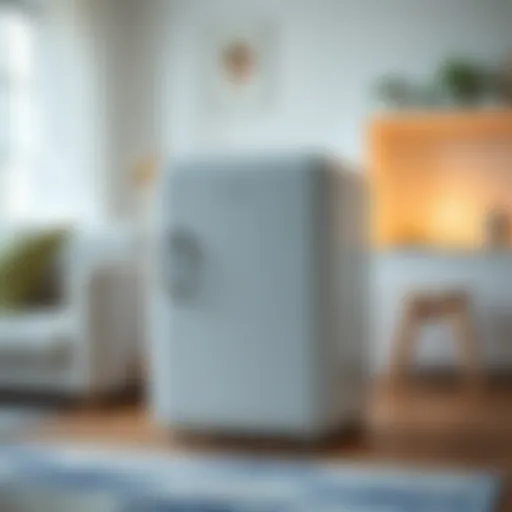Exploring Fabric Cubes: Functional Elegance in Design
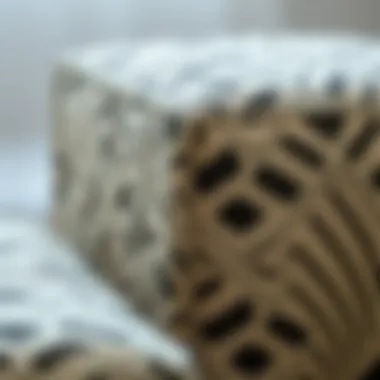
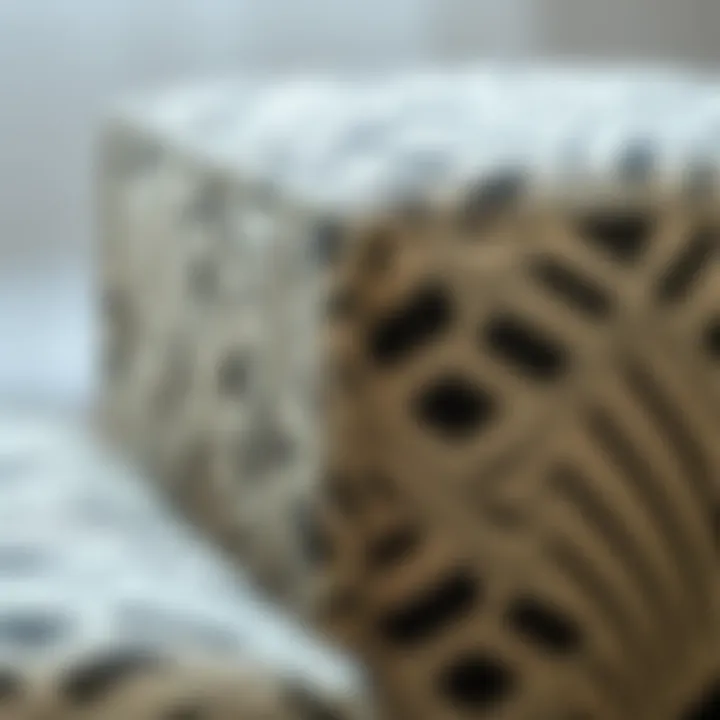
Intro
The modern world of design is all about balancing beauty and functionality, and one of the artistic solutions making waves today is the fabric cube. Seemingly straightforward in shape, these versatile elements offer much more than just a place to rest your feet or stack books. Fabric cubes can transform a space, enhance comfort, and even serve as organizational heroes in a room.
The Rise of Fabric Cubes
Over the past few years, fabric cubes have carved a niche in interior design. They bridge the gap between style and practicality, with availability in numerous materials and colors. Whether crafted from soft velvet or durable canvas, these pieces have an uncanny ability to adapt to various aesthetics—modern, bohemian, minimalistic—you name it! They are like chameleons in home decor, blending seamlessly while also standing out in their own right.
This article takes readers on a journey through the myriad applications of fabric cubes in contemporary settings. We'll explore current design trends, buying tips, and how best to integrate them into your home. From casual living rooms to professional interiors, this guide promises insights valuable for homeowners, designers, and DIY enthusiasts alike.
"Functional design should never be boring. Elegance can be seen in the simplest forms; look at the fabric cube."
As we delve into this exploration, you’ll find practical advice on harnessing the power of fabric cubes to elevate your everyday spaces.
Defining Fabric Cubes
In the rich tapestry of modern design, fabric cubes emerge as both functional items and aesthetic marvels. Understanding what fabric cubes are, along with their historical background, is crucial for homeowners, designers, and anyone interested in enhancing their living spaces. These seemingly simple pieces of furniture can significantly alter the feel of a room, offering flexibility, comfort, and style. Through defining fabric cubes, we delve into their multifaceted roles in contemporary design and how they bring together functionality and elegance.
What Are Fabric Cubes?
Fabric cubes are versatile seating and storage options crafted from a range of textiles. Their geometry, often a square or rectangular prism, makes them incredibly adaptable. They can be used as seats, footrests, or even as playful decor, depending on the needs of the space. Imagine a soft, cushy cube in the corner of your living room, ready to welcome guests or serve as a makeshift table when needed; that's the beauty of fabric cubes.
These pieces can come filled with foam, beans, or even recycled materials, which adds to their comfort level. Adding to their charm, fabric cubes are available in countless designs, colors, and patterns, ensuring there's something for every taste and interior design style. Homeowners, designers, and retailers all appreciate their ability to combine practicality with visual appeal – a lure that does not go unnoticed in bustling homes or chic offices alike.
Historical Context of Fabric Cubes
The journey of fabric cubes in furniture design is both fascinating and reflective of wider trends in interior decor. Historically, seating options were heavily influenced by practicality and the types of materials available at the time. As urban living spaces grew smaller and the need for multifunctional furniture became a priority, fabric cubes gelled into the narrative.
In mid-twentieth century, with the beginning of modular furniture designs, fabric cubes began to gain traction as an essential component of modern living. They offered convenience and could glide seamlessly into various arrangements. From the post-war embrace of simplicity in design to the bold experimentation of the 1960s and 70s, fabric cubes adapted and evolved.
Now, as sustainability becomes a focal point in the design industry, many fabric cubes are crafted from eco-friendly materials, further solidifying their relevance in contemporary settings. For example, many designers are opting for organic cotton or recycled polyester in their fabric cube collections. This shift not only aligns with current consumer preferences but also speaks to the ongoing evolution of design as it adapts to technological and societal changes.
"Every era has its style, and fabric cubes have found their way through seamlessly, embracing not just function but also a sense of place in every room they inhabit."
This historical context helps frame fabric cubes not merely as furniture pieces, but as part of a larger conversation about how our living environments are shaped. Understanding this timeline and transformation offers invaluable insights and appreciation for this often-overlooked item in modern decor.
Diverse Applications of Fabric Cubes
The significance of fabric cubes stretches far beyond their immediate aesthetic appeal. When one delves into the diverse applications of these versatile pieces, it becomes clear that they embody more than just functionality; they represent a blend of style, comfort, and practicality that transcend the conventional boundaries of design. Fabrics cubes have ingrained themselves in various spaces, adapting to the needs and preferences of homeowners, designers, and decorators alike. The flexibility they offer resonates profoundly with contemporary living, making them a staple in modern decor.
Seating Solutions
Accent Chairs
Accent chairs serve as an exemplar of how fabric cubes can enhance seating arrangements. These chairs come in different forms, from plush designs to sleek, minimalistic lines. One key characteristic of accent chairs is their ability to serve as statement pieces within a room without compromising the space. They can break the monotony of standard seating while maintaining a sense of coherence in design.
The unique feature of accent chairs often lies in their vibrant colors or bold patterns, drawing attention while complementing existing decor. Though they provide both style and comfort, one must consider their placement; too many bold accent chairs can overwhelm a space. Overall, well-chosen accent chairs add a layer of elegance to any setting.
Poufs
When it comes to poufs, their contribution to the fabric cube realm is notably valuable. These pieces offer a relaxing spot to kick up your feet or even provide extra seating when needed. The key characteristic that makes poufs popular is their versatility; they can fit into nearly any decor style, from bohemian to modern minimalism. Their soft, often rounded shapes make them inviting and functional, combining utility with playful charm.
The unique feature of poufs is their lightweight design, which allows for easy repositioning, adapting to the dynamic needs of any lifestyle. While they are incredibly useful, there may be some considerations regarding their cleaning. As they often lack a rigid structure, keeping them looking sharp requires regular upkeep, but their benefits far outweigh such inconveniences.
Ottomans
Ottomans bring a distinct aspect to the conversation of fabric cubes, adding dimension to both functionality and style. They function not only as footrests but also as table substitutes, making them highly adaptive. The standout characteristic of ottomans is their dual functionality—offering both a surface for trays and a comfy spot to recline after a long day.
Unique to ottomans is their potential for storage; many designs feature hidden compartments, efficiently utilizing space. However, the biggest downside may be that their soft tops can be less ideal for serving food or drinks, where a stable surface is preferred. Still, the ability to blend luxury with practicality makes ottomans a favorable choice in countless settings.
Storage Options
Organizational Strategies
Organizational strategies implemented through fabric cubes illustrate the growing need for functionality in modern spaces. These options excel in promoting a clutter-free environment. The main characteristic of organizational strategies lies in their innovative design; many fabric cube storage systems can be neatly tucked away when not in use, making them incredibly efficient.
A unique aspect of these organizational methods is their ability to combine aesthetic appeal with utility. For instance, fabric cubes that morph into chic storage bins add both flair and functionality, appealing to home decorators. A possible downside could be their fabric construction; while it offers versatility, it may not provide the durability some homeowners desire in heavy-duty storage solutions.
Multi-Functional Uses
Multi-functional uses of fabric cubes significantly contribute to versatile living spaces. These cubes often serve several purposes, from storage to seating, reflecting the changing needs of households. The core characteristic is their adaptability—one piece can transform from a footrest to a side table, proving invaluable in smaller homes.
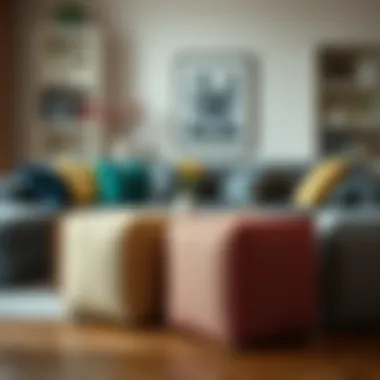

Moreover, unique to multi-functional fabric cubes is their space-saving ability; they can collapse or stack away when not needed, enhancing room dynamics. However, a disadvantage might involve limited weight capacity, depending on the design. Despite this, their all-in-one aspect positions them as an ideal solution for maximizing space functionality.
Decorative Elements
Color and Texture
Color and texture are vital contributors to the overall aesthetic harmony of fabric cubes, allowing space to come alive with personality. A striking characteristic of their use is the ability to mix and match colors to create visual interest. Fabric cubes can introduce depth to a room through rich patterns or varying textures.
The unique advantage is their potential for layering—placing contrasting cubes beside each other plays off both color and texture, enhancing design depth. However, too many competing textures can create discord, which may require careful curation to avoid overwhelming a space. The thoughtful integration of color and texture makes fabric cubes an essential ingredient in successful interior design.
Layering in Design
Layering is another powerful concept in design that fabric cubes support very well. This strategy involves combining various elements to create an inviting and dynamic visual story. The key characteristic of layering with fabric cubes is how it adds complexity and warmth to a design; strategically layering different sizes and colors creates a welcoming scene.
One unique feature in this layering technique is the ability to swap out cubes seasonally or with changing decor trends; this flexibility enhances the longevity of design choices. While layering can elevate a room, it also calls for careful balance; over-layering can lead to a cumbersome feel. Nonetheless, effective layering positions fabric cubes as not just functional but as transformative elements within any space.
Material Selection for Fabric Cubes
Choosing the right materials for fabric cubes can make or break their integration into a living space. The material acts as the backbone of a cube's functionality and aesthetic appeal, influencing everything from durability and maintenance to comfort. For homeowners and designers alike, knowing the ins and outs of fabric selection not only adds to the cubes' visual charm but also changes how well they perform in various settings. The selection process involves weighing the pros and cons of different materials, considering their sustainability, and how they align with current trends in design.
Types of Fabrics
Cotton
Cotton is one of the most widely used fabrics for fabric cubes, and for good reasons. It's known for being breathable, soft, and versatile. Aside from its natural feel, cotton can be dyed easily, allowing for a wide range of colors and patterns that can complement any decor. This makes it a popular choice whether you're going for a cozy, rustic look or something more modern. However, one downside to cotton is its susceptibility to stains; without a protective coating, it may not be the best option for homes with children or pets.
Polyester
Polyester has become increasingly popular in the world of fabric cubes, thanks to its durability and resistance to wrinkling and fading. It’s particularly advantageous for those who seek low-maintenance options, as it can be easily cleaned and often withstands daily wear and tear. Additionally, polyester can mimic the look of more expensive fabrics without the hefty price tag, striking a balance between style and functionality. However, it's worth noting that polyester might not breathe as well as cotton, which can make it less comfortable in hot weather.
Natural Fibers
Natural fibers encompass a variety of materials, including wool, linen, and hemp. These fabrics offer unique textural qualities and a distinct aesthetic, often elevating a room's overall appeal. For instance, wool is known for its warmth and resilience, while linen provides a crisp, relaxed feel. The use of natural fibers aligns well with the growing trend towards sustainable living, as many of these materials are biodegradable and eco-friendly. Yet, some natural fibers may require special care or may not be as durable as synthetic alternatives, so those are considerations to keep in mind.
Sustainability Considerations
Eco-Friendly Materials
With a rising awareness of environmental issues, the demand for eco-friendly materials in fabric cubes is climbing. These materials are typically sourced from sustainable practices and crafted with reduced environmental impact in mind. For example, organic cotton and recycled polyester not only minimize waste but also contribute to healthier living spaces. Using eco-friendly materials ensures that you’re not just choosing style but also supporting responsible manufacturing practices. A potential drawback might be the higher cost, although many find the long-term benefits worth it.
Responsibility in Sourcing
Finding fabric cubes made from responsibly sourced materials is increasingly valuable. This means choosing products that prioritize ethical labor practices and environmentally sustainable processes. Many reputable brands today are transparent about their sourcing methods, providing information on where materials come from and how they are produced. This not only educates consumers but also builds trust. Although it might take a bit more effort to research and buy from these companies, it supports a marketplace that values ethical considerations alongside aesthetic ones.
As you navigate through material selection for fabric cubes, remember that it’s not just about fabric but how these decisions influence your living environment. The fabrics you choose can echo your style, support the planet, and ultimately impact the functionality of your space.
Design Trends Featuring Fabric Cubes
In today's ever-evolving design landscape, fabric cubes are becoming increasingly prominent. Their unique blend of form and function complements a range of styles while offering homeowners practical solutions for modern living. The significance of examining design trends surrounding fabric cubes lies in their versatility. This exploration not just uncovers aesthetic qualities but also emphasizes how these items can adapt to various interior environments. Key elements such as color choices, material innovations, and spatial arrangements play a central role in shaping how fabric cubes enhance contemporary spaces.
Contemporary Aesthetics
Fabric cubes seamlessly bridge the gap between style and practicality. In contemporary aesthetics, their clean lines and rich textures bring a modern touch to any room. Unlike traditional bulky furniture, fabric cubes present a more streamlined look. They come in various colors and patterns, allowing homeowners to express their individual tastes. The possibility of mixing and matching these cubes offers an easy way to switch up a room’s look without a total redesign.
- Soft lines vs. sharp edges: In many cases, these cubes harmonize with a minimalist approach that emphasizes soft shapes, contrasting beautifully with the sharp edges commonly found in modern decor.
- Layering effects: Their adaptability means they can be layered with other design pieces, which enhances both visual depth and functionality.
Utilizing fabric cubes as focal points can steer the overall aesthetic. For instance, a bold-patterned cube can become a conversation starter when placed amidst neutral-toned furniture. Additionally, the ability to use fabric cubes in various settings, such as in a living room or as extra seating in a bedroom, speaks to their adaptability in contemporary interiors.
Industrial Influences
The trend of industrial design has made its way into many homes, bringing a raw charm that contrasts perfectly with the soft textures of fabric cubes. In industrial influences, exposed brick walls, metal accents, and wooden beams can provide a rich backdrop against which fabric cubes shine. This juxtaposition creates a balance, softening the harshness often associated with industrial decor.
Fabric cubes used within an industrial context offer:
- Contrast: Plush fabric cubes can break up the rigid appearance of metal and concrete.
- Functional piece: They can serve as both seating and side tables while maintaining the rugged charm.
Pairing fabric cubes with industrial elements encourages a playful approach to design. For example, a grey fabric cube can beautifully complement a steel frame coffee table, creating a harmonious yet eclectic arrangement.
Minimalism and Functionality
Minimalism is more than just a design style; it’s a lifestyle choice for many. With a focus on simplicity and functionality, fabric cubes fit neatly into this framework. They offer minimalistic designs without compromising on utility, making them essential for clutter-free living. The essence of minimalism lies in the notion that less is more, and fabric cubes embody this principle by providing clear lines, essential pieces, and ease of movement.
Key benefits of integrating fabric cubes into minimalist designs include:
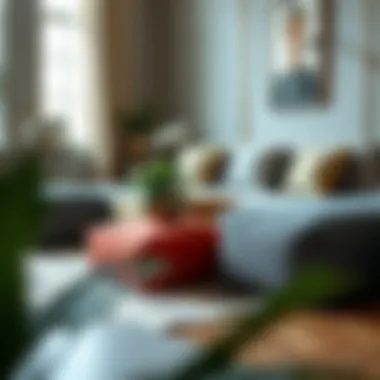

- Efficiency: An ability to serve multiple purposes – from seating to storage.
- Space-saving: Their lightweight nature makes them easy to arrange or tuck away when not in use.
By choosing fabric cubes that align with minimalism, homeowners can create serene environments that encourage calm and focus. The result is a stylish yet functional space that reflects an organized aesthetic without feeling sterile.
"Incorporating fabric cubes into modern design is not merely about aesthetics. It's an ingenious balance of elegance and innovation."
In summary, the design trends featuring fabric cubes highlight their adaptability across different styles, such as contemporary, industrial, and minimalist. Whether serving as a statement piece or a subtle addition, fabric cubes are poised to remain integral to the future of home decor.
Incorporating Fabric Cubes in Various Spaces
In the realm of modern interior design, fabric cubes are not merely aesthetic choices; they play crucial roles that go beyond mere decoration. Their adaptability allows them to be seamlessly integrated into various spaces within a home or workspace, each with distinct challenges and opportunities for enhancing functionality and style.
Living Room Designs
Color Coordination
Color coordination within a living room serves as a foundation for creating an inviting atmosphere. It’s not just about slapping color on the walls and hoping for the best. It’s about creating a harmonious blend of shades that resonate with the overall vibe of the house. Fabric cubes come in a range of colors and patterns, making them perfect for accentuating this aspect.
The key characteristic of effective color coordination is creating a balance. For example, a soft blue fabric cube can contrast beautifully against a warm beige sofa, drawing the eye while maintaining serenity. The benefit of this lies in visual resting spots, allowing the space to breathe without overwhelming the senses. However, overdoing the color palette can lead to chaos, which is something to be wary of when introducing cubes into the equation.
Space Optimization
In today’s world, optimizing space has become a necessity rather than a luxury. Fabric cubes are petite but powerful tools that can fit snugly into corners, providing additional seating or storage without compromising the flow of a room. Their modular nature allows for easy rearrangement, making them especially appealing in living rooms where social interactions are key. The unique feature of space optimization with fabric cubes is their ability to transform lifestyles.
Whether it’s hosting a gathering or winding down with family, how the space is used can change. Still, the drawback sometimes lies in their size—if you miscalculate how many to incorporate, it may lead to clutter instead of a cozy arrangement.
Children's Spaces
Safety Features
When it comes to children's spaces, safety takes precedence. Fabric cubes can be cushioned and soft, reducing the chances of injury during plays. Their compact nature means they can be tucked away if needed, clearing the floor for playtime. The simple characteristic of safety features is their rounded designs, which eliminate sharp edges.
Choosing fabric cubes made from non-toxic materials adds an additional layer of safety. The main benefit is peace of mind for parents, knowing their little ones can play freely without constant watchfulness. However, one consideration is that some softer materials may not withstand rigorous use as well as others, so selecting durable fabrics is essential.
Playful Designs
Playful designs significantly contribute to stimulating a child’s imagination and creativity. Fabric cubes can be adorned with whimsical patterns, bold colors, or even educational themes like the alphabet or animals. This characteristic makes them not just functional but also engaging for children.
For instance, a cube featuring cartoon animals can serve as a delightful conversation starter among kids. The advantage here is the encouragement of play and learning through interaction. The potential downside, however, is that as children grow, their tastes and needs will change, requiring adjustments or replacements over time to keep up with their evolving personalities.
Office Environments
Versatile Seating
In office environments, the need for versatile seating has never been more pressing. Adjustable seating options created by fabric cubes allow for a flexible workspace that accommodates various activities, from brainstorming sessions to casual catch-ups. Their lightweight design means they can be moved effortlessly, allowing employees to create their desired workspace configuration.
The pivotal feature here is functionality; the easy reconfiguration promotes collaboration among teams. However, this versatility can sometimes lead to a lack of permanent seating solutions, which may not be appealing for all individuals who prefer the stability of traditional office furniture.
Creative Workspaces
A creative workspace thrives on inspiration and innovation, and fabric cubes can instantly contribute to that ambiance. By incorporating cubes with bright colors or unique textures, you can create an environment that stimulates creativity and out-of-the-box thinking.
The signature aspect of such environments is their ability to adapt to different modes of work. The advantage is that diverse settings can cater to various working styles, from individual tasks to group projects. On the flip side, if the workspace becomes too eclectic, it might hinder focus instead of enhancing productivity.
Integrating fabric cubes into various spaces adds a multifaceted appeal that blends functionality with creativity. They bring life and versatility into living areas, children's spaces, and offices alike. By considering aspects like color coordination, safety features, and the overall layout, one can craft environments that not only look great but also serve practical needs.
Practical Benefits of Fabric Cubes
The rise of fabric cubes in contemporary design reflects a shift towards both functionality and aesthetic versatility in home furnishings. Homeowners, designers, and retailers are noticing how these cubes serve more than just an ornamental purpose. Understanding their practical benefits can influence decisions made in both casual designs and sophisticated projects.
Comfort and Ergonomics
Fabric cubes are often perceived merely as trendy accessories, yet they embody a practicality that enhances daily comfort. When it comes to furniture, comfort is paramount, and fabric cubes can make a distinction. Many of these cubes are filled with high-quality foam or other soft materials, offering a cozy seating option that you can kick back on after a long day. Unlike traditional seating that may conform to rigid styles, fabric cubes provide a friendly, adaptable surface that invites relaxation.
Moreover, they can cater to ergonomic needs without much fuss. You can easily find cubes designed with height and cushioning that support proper posture. For those who work from home, using fabric cubes can create an informal space where you can sit cross-legged or prop your feet up, enhancing your comfort during extended periods of sitting. It's a different kind of relationship between you and furniture – one that prioritizes ease over formality.
Portability and Flexibility
One of the standout features of fabric cubes is their unrivaled portability. You can easily move these cubes from room to room, or even take them outdoors. This is perfect for those who entertain frequently. Just imagine transforming your living room into a vibrant gathering space or a backyard for a barbecue by shifting around easily movable fabric pieces that adapt to your needs.
Flexibility goes hand-in-hand with portability. Fabric cubes can serve multiple functions–as seating, footrests, or even small side tables when needed. With some creative arrangement, they can be a child’s play area or even extra storage when filled with toys or other items. This adaptability allows homeowners to marginally restructure their environment without investing in a complete overhaul, making it an excellent choice for those who appreciate dynamic living spaces.
"Furniture that moves with us and adjusts to our needs is not merely a benefit, it’s a necessity in modern living."
Overall, the practical advantages of fabric cubes resonate significantly with the evolving landscape of interior design, where functional elegance is key. As these benefits unfold, they signal to the discerning audience of designers and homeowners the growing relevance of this seemingly simple item in creating harmonious, functional spaces.
Challenges to Consider
When it comes to fabric cubes, it’s easy to get swept away by their potential to blend functionality with elegance. Yet, like any design choice, there are pitfalls that deserve a closer look. Examining the challenges surrounding fabric cubes is not only vital for making informed decisions but also helps maximize their potential in contemporary interior design. Let’s delve deeper into two critical concerns: durability and maintenance, along with selecting the right size.
Durability and Maintenance
Durability plays a crucial role in furniture selection, especially for items that may see heavy use, like fabric cubes. The right fabric can withstand the daily wear and tear. Consider heavy-duty options like canvas or tightly woven upholstery that can resist scuffs and spills. Choosing materials that undergo special treatments for stain resistance can be a game changer.
Maintaining fabric cubes shouldn’t be a daunting task either. A fabric cube in a prominent spot—like the living room—will likely encounter a few mishaps. Regular cleaning can prevent dirt accumulation, while the choice of removable covers facilitates easy washing. However, some fabrics may become pilled or fade over time. To mitigate this risk, opting for UV-resistant options, if the cube is in a sun-heavy room, proves helpful.
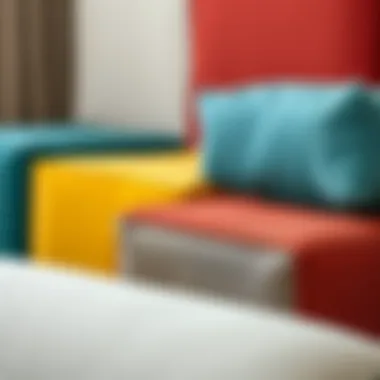
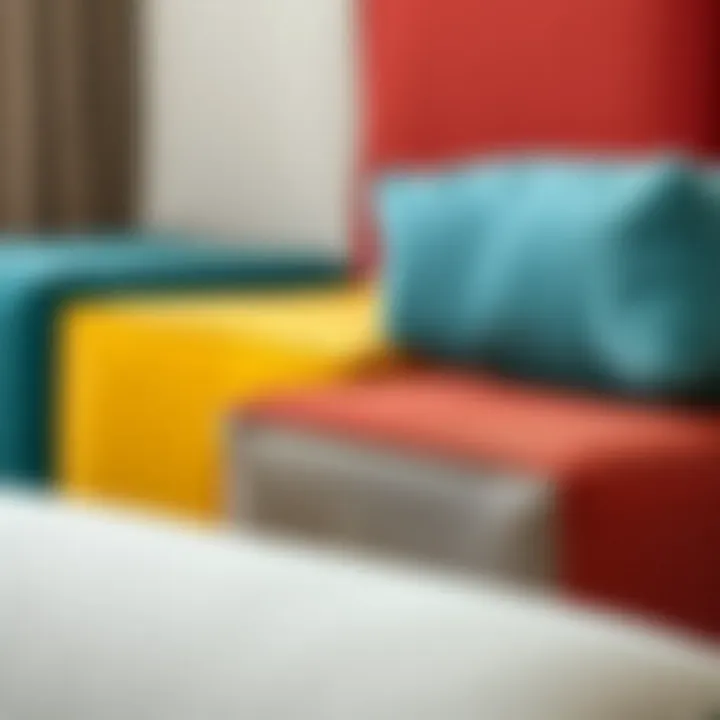
In summary, understanding the durability of the fabric used in cubes directly impacts their longevity. Furthermore, easy maintenance ensures that these functional elements are not only beautiful but also practical, calling for less time fussing and more time enjoying.
Selecting the Right Size
Selecting the right size for fabric cubes might seem straightforward, yet it’s vital for achieving the right aesthetic and functional balance in a space. A cube too small can be lost in a vast room, while one that’s too bulky may overwhelm smaller spaces. Dimensions should cater to both the intended use and the existing layout.
Thinking about the positioning is key. For instance, if a fabric cube doubles as seating, ensuring that it aligns with the height of other seating options is essential. Furthermore, cubes placed near areas of frequent movement should not compromise the flow of foot traffic.
Here are a few considerations to bear in mind when selecting size:
- Purpose: Is it mainly for seating, storage, or decorative elements?
- Space constraints: Measure the intended area while keeping in mind the surrounding furniture.
- Multi-functionality: If the cube is to serve multiple roles, ensuring it can match contrasting needs is critical.
- Visual proportions: Consider the overall theme and adjust size accordingly to maintain harmony in space.
Ultimately, investing thought into the size of fabric cubes is essential. Properly scaled pieces will enhance room dynamics by promoting comfort and usability, thus elevating the overall decor.
Comparative Analysis: Fabric Cubes vs. Other Furniture
In the vast landscape of modern furniture design, distinguishing the unique qualities of fabric cubes from other furnishings is essential for anyone looking to optimize space and aesthetics. Fabric cubes have carved out a niche that not just emphasizes style but also boasts versatile functionality. Analyzing how these cozy cubes stack up against traditional furniture and modular options sheds light on their myriad benefits and considerations.
Fabric Cubes vs. Traditional Furniture
When one thinks about traditional furniture, images of rigid sofas, bulky armchairs, and fixed dining sets often come to mind. While these pieces have their charm, they don’t always offer the flexibility that fabric cubes do. Fabric cubes are not merely decorative; they serve practical purposes. Here are several ways in which they outshine traditional options:
- Flexibility: Fabric cubes can easily be rearranged, thus creating a dynamic space that can change with your needs. Whether you’re hosting friends or looking for some downtime, a few moves can shift a living room from formal to relaxed.
- Space-Efficiency: Unlike cumbersome furniture, fabric cubes can tuck away into smaller areas when not in use. Their lightweight nature means you can shift them around as needed without breaking a sweat.
- Cost-Effectiveness: Often, fabric cubes come with a lower price point than traditional seats or tables, making them a budget-friendly option for homeowners looking to enhance their décor without breaking the bank.
"In a world where adaptability is key, fabric cubes signal a shift toward multifunctional spaces."
Fabric Cubes vs. Modular Options
While modular furniture promises a degree of customization, it often requires a set commitment to a specific arrangement. Fabric cubes, on the other hand, represent a more versatile approach. Here’s a breakdown of how these two categories compare:
- Immediate Use: With modular furniture, the assembly process can be daunting and time-consuming. Fabric cubes, on the other hand, are ready to use right out of the box. You can add them to your space without waiting.
- Aesthetic Play: The range of colors and fabrics available in fabric cubes allows for a more vibrant interplay of textures and shades. This is something that modular systems may lack, often focusing on uniformity and structure.
- Adapatable Solutions: Fabric cubes can serve dual functions, acting as seating, tables, and decorative pieces, allowing for a unique blend of usability. Modular furniture may require additional elements to achieve a similar effect.
Future of Fabric Cubes in Design
As we look ahead, the importance of fabric cubes in modern design cannot be overstated. These versatile pieces are not mere accents; they encapsulate a blend of style and functionality that is essential in contemporary interiors. Fabric cubes will likely evolve in response to changing consumer preferences, technology, and material advancements, shaping not just how we furnish our spaces, but also how we experience them. In this section, we will explore the mesmerizing innovations in materials that are setting the stage for the fabric cubes of tomorrow, as well as the evolving design trends that influence their integration in stylish and functional ways.
Innovations in Materials
Innovations in materials are pivotal in the realm of fabric cubes. Today’s consumers are more conscious than ever about the environmental impact of their choices, and this is prompting designers and manufacturers to seek out new, sustainable materials.
- Recycled Fabrics: Designers are increasingly using fabrics made from recycled plastics or textiles. These options not only reduce waste but also offer unique textures and colors, creating a statement piece that tells a story.
- Smart Fabrics: The inclusion of technology into textiles is growing. Imagine a fabric cube that can change its color or temperature based on the environmental conditions. Materials with embedded sensors can adjust to user preferences, enhancing comfort and customization.
- Biodegradable Materials: As the call for sustainability rises, using biodegradable fabrics could become more prevalent. This means when a fabric cube reaches the end of its life cycle, it will not contribute to environmental harm, thereby appealing to eco-conscious consumers.
Overall, the innovations in material selection not only address aesthetic concerns but also cater to a responsible mindset. As options become more varied, fabric cubes can take on new roles, evolving not just as functional furniture but also as symbols of environmental stewardship.
Evolving Design Trends
In tandem with material advancements, design trends surrounding fabric cubes are also shifting dramatically. The contemporary consumer seeks more than mere functionality; they desire pieces that resonate emotionally and create an ambiance within their spaces.
- Mixing Textures: The trend towards mixing and matching different fabrics and textures is on the rise. Homeowners are no longer confined to matching sofas and chairs. Instead, fabric cubes featuring bold patterns or contrasting materials can act as cohesive focal points in rooms filled with layered designs.
- Bold Colors: Vibrant colors are experiencing a comeback, with fabric cubes available in many vivid hues. This allows for personalized expression through furniture—offering a break from the monotonous color schemes of the past, and reflecting individual tastes.
- Adaptable Furniture: As living spaces become smaller, especially in urban settings, there’s a focus on furniture that is easily adaptable. Fabric cubes can serve various purposes—from extra seating to casual coffee tables—offering flexibility without compromising style.
In this dynamic landscape, the future of fabric cubes is not just about following trends, but also about anticipating the needs of the modern individual. Those who appreciate thoughtful design will find fabric cubes to be an essential component in crafting their ideal environments.
"The evolution of fabric cubes in design reflects a blend of innovative materials and adaptable trends, serving as a testament to the ever-changing needs of modern living."
As we face a future rich with possibilities, it’s clear that fabric cubes are here to stay, continually redefining their role in the decor and furniture landscape. Whether it’s through smart technology integration or sustainable practices, the journey of these pieces is just beginning—inviting all of us to imagine new ways to utilize them.
End
In wrapping up our exploration of fabric cubes, it becomes clear just how pivotal these items are in the realm of modern design. With their ability to blend functionality with style, fabric cubes prove to be essential elements in interior settings. The versatility of fabric cubes extends beyond mere aesthetics; they are practical solutions to a host of everyday needs. Their adaptability in various environments—from cozy living rooms to energetic children’s spaces and efficient office setups—demonstrates their capacity to cater to diverse requirements and tastes.
Summarizing Key Takeaways
Fabric cubes serve multiple purposes, making them valuable in many applications. Their main attributes include:
- Versatility: They can function as seating, storage, or decorative pieces, adjusting seamlessly to the flow of life in a home.
- Aesthetic Appeal: Available in countless fabrics, colors, and designs, they can either stand out as statement pieces or blend harmoniously with existing decor.
- Practical Benefits: Beyond looks, fabric cubes are often lightweight and easy to move, fitting perfectly into tight spaces while still providing comfort.
- Eco-Conscious Choices: Many fabric cubes are made from sustainable materials, aligning with a growing emphasis on ethically made furniture.
As we reflect on these points, it’s evident that fabric cubes bring a unique touch that transforms spaces.
Encouraging Thoughtful Selection
When choosing fabric cubes, it's important to consider a few aspects that can significantly impact their effectiveness in your space:
- Purpose and Functionality: Understand how you intend to use the fabric cube. Will it be primarily seating, storage, or a decorative piece? This directs your selection process.
- Material and Durability: Opt for fabrics that align with your lifestyle. For instance, families with children may prefer more resilient materials like synthetic blends, while those who focus on aesthetics might lean towards luxurious cotton or linen.
- Color and Design Scheme: Select colors that complement your decor, yet don't be afraid to experiment with bold choices. Fabric cubes offer a relatively low-commitment way to introduce striking colors or patterns to your surroundings.
- Investment Value: Considering the importance of sustainability, it may be prudent to invest in high-quality, eco-friendly fabric cubes that not only serve functional purposes but also make a responsible choice for the planet.
By taking each of these factors into account, one can ensure to choose fabric cubes that not only enhance functionality but also breathe life and elegance into their living spaces.
"Functional elegance in design is not just about looking good; it’s about living well with purpose."
Ultimately, fabric cubes are not mere inserts in a room. They reflect careful thought about one's surroundings, marrying comfort and adaptability with striking beauty. Choosing the right pieces can drastically redefine a space, making it more welcoming and efficient.
